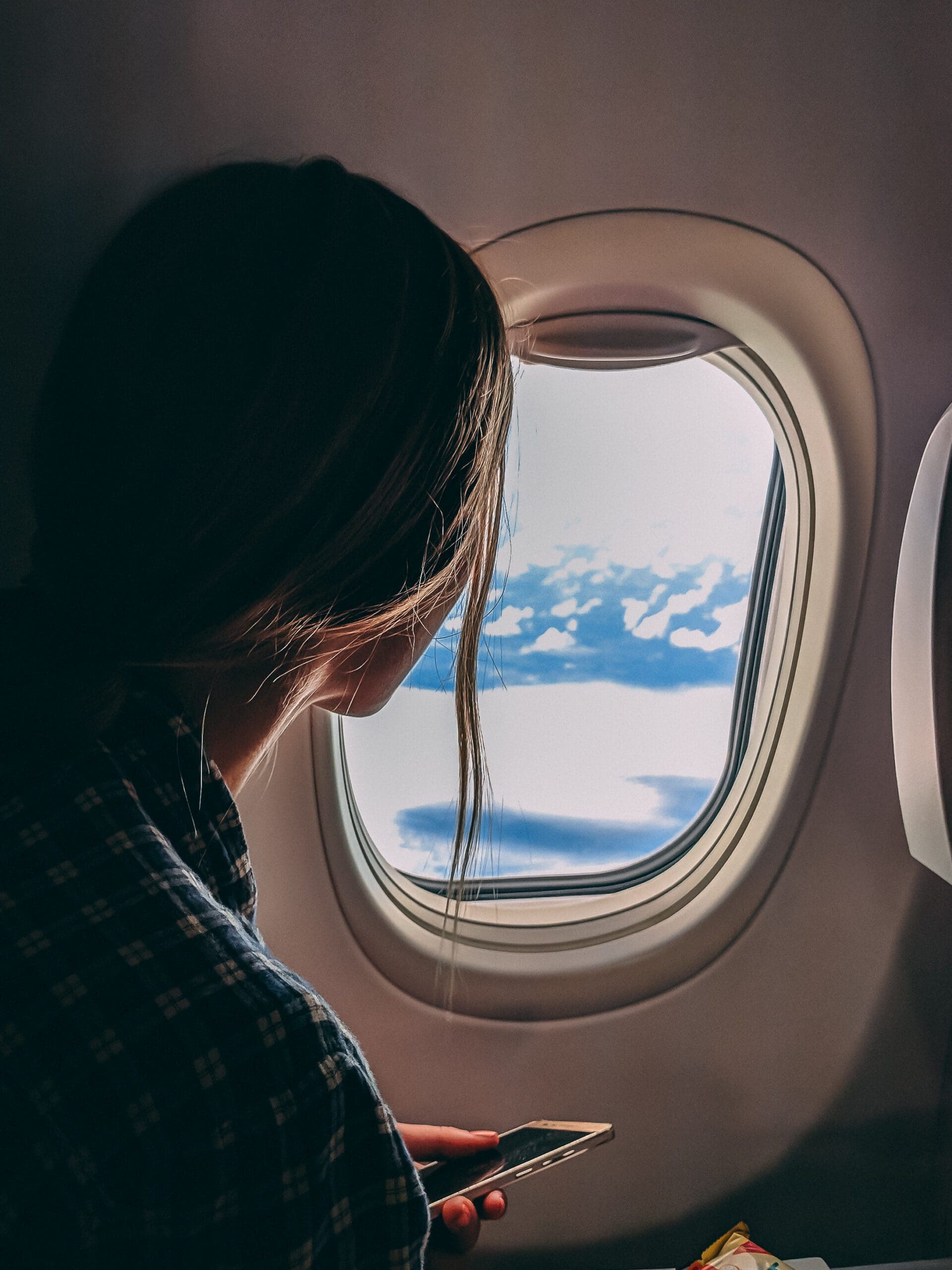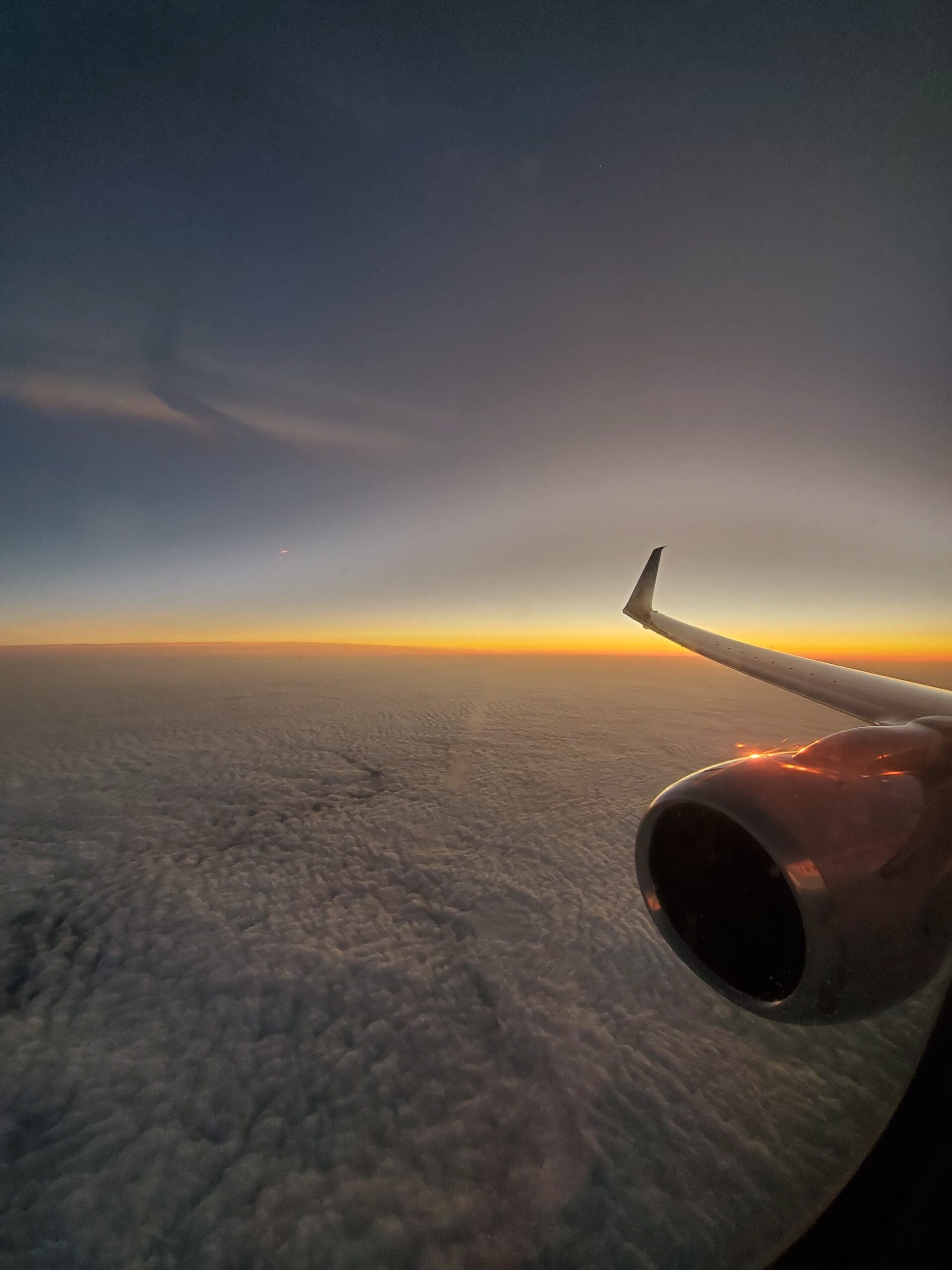
Flying with a Pet: A Comprehensive Guide to Easy In-Cabin Pet Travel
Table of Contents
Introduction
There are few things I love more than traveling with my small dog Loki. He’s my best friend, my hiking companion, and all-around battle buddy. Without proper preparation however, flying with a pet can be a stressful experience for both you and them. Your travel plans can be completely derailed and you could be on the hook for all the applicable fees.
My dog has been to more countries, and on more international flights, than most people.
I’ll eventually write a Comprehensive Guide to Easy International Pet Travel because it’s its own beast. International travel is a challenging topic because every country – and even different international destinations or international locations within a country – have different rules and requirements. That’s why, for this guide, I’ll be primarily discussing domestic pet travel within the United States and how to prepare your pet.
Canada is the one exception. Flying with a pet to Canada is easy as long as your dog is older than 8 months. You just need a valid rabies certificate and a pet that appears in good health upon inspection by the Canadian Food Inspection Agency. While dogs and cats can enter Canada without health certificates, birds cannot. Here is the USDA on the subject.
As far as domestic destination requirements, please know that there are special government regulations when traveling to the State of Hawaii. As an example, Hawaiian Airlines has specific requirements that allow pets in cabin when leaving Hawaii or when traveling between islands, but not when going TO Hawaii.
Getting a Carrier For Pet
If you’re considering traveling with a carry-on pet, this comprehensive guide is designed to help you navigate the process and ensure a pawsome adventure for everyone involved! While the cargo hold is available for both domestic flights and international trips, it is much easier if you are able to fly with your pet in cabin.
Now, you are typically allowed to only one animal per person per carry on AND need an airline approved in-cabin pet carrier. The only flexibility on this is typically if your dog or cat is still a baby, in which case they can be placed with animals of a similar size.
I would still anticipate needing to pay the pet travel fee for both pets though. The airline will often ask the number of pets, size of your pet, and the combined weight of the pet and carrier.
Typically, people use soft-sided carriers. It should have breathability on at least three sides, and have enough space for your pet to stand up, turn around, and lie back down inside. Your local pet store will sell some.
I use the Sleepypod Air . (Not an affiliate link, I just like the product). It’s a fantastic and well-made carrier that is tested up to child safety standards. It’s got a washable interior, extends to give your pet more room under the seat, and is tested to the same standards as infant car seats.
They have another version, the Sleepy Pod which is great for the car but you need the Sleepypod Air for Air travel.
Tips to Prep Your Pet for the Flight
I CANNOT stress this enough and this simply can’t happen too soon. The best time to plant a tree was 20 years ago – the second-best time is now. Start now. If you skip every other piece of advice, remember this. If your pet loves their carrier, your travel experience will be so much more incredible than if they hate it.
Most small pets only end up in their crate on the way to the vet, but the ability to be crated is very important for a traveling pet. My dog Loki loves his carrier. He knows if his carrier comes out that he gets to come on the adventure and won’t be getting left behind. He hurls himself enthusiastically into his carrier.
When you fly, your pet needs to stay in their carrier the entire time – “the duration of the flight”. If there is a delay on the tarmac, that is all extra time they are in their carrier.
But HOW do you train this?
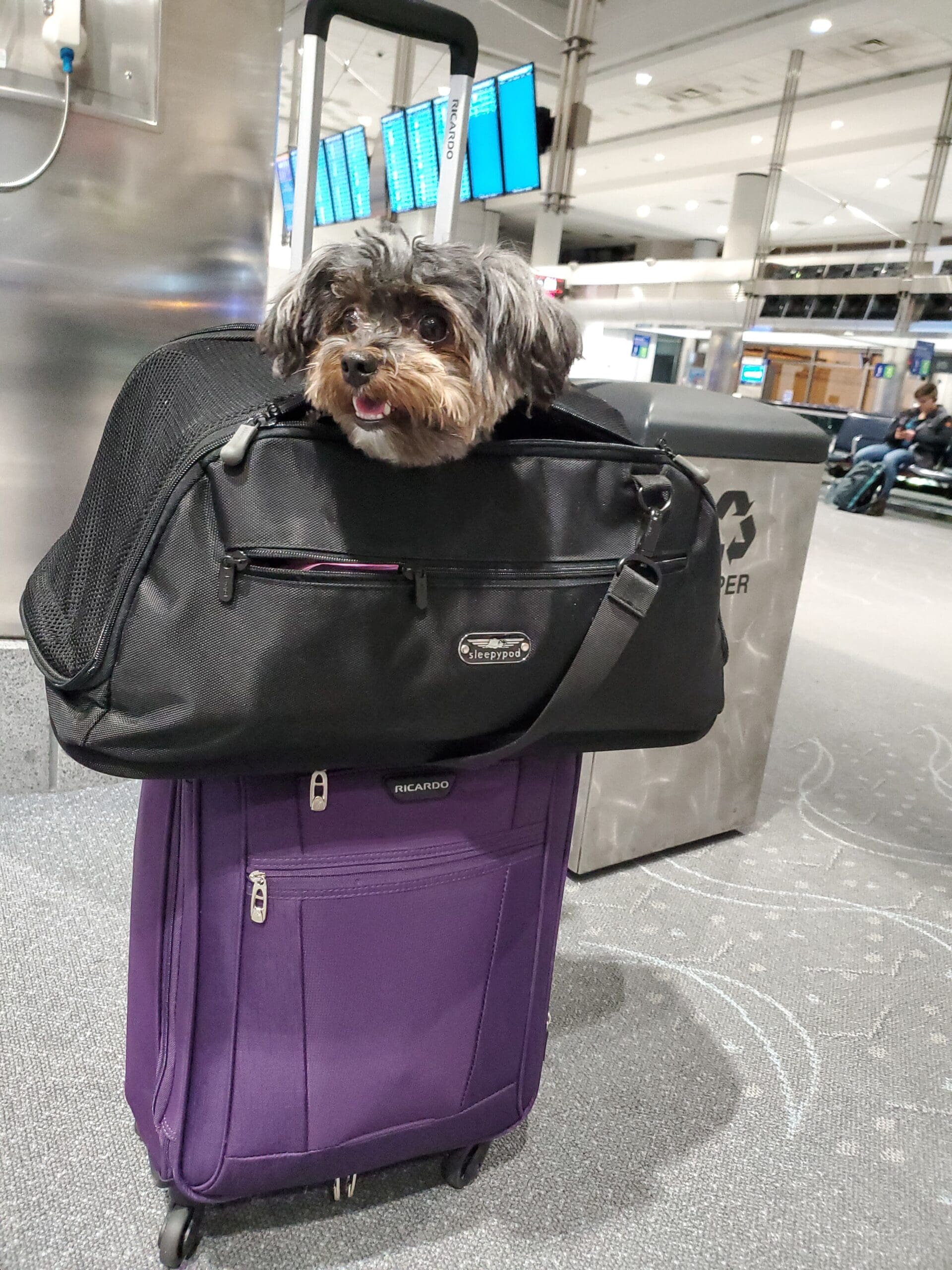
Get Your Pet Used to the Carrier before Flying with a Pet:
Keep the carrier in the room you and your pet use most. This carrier should become a natural part of your pet’s environment. They should be able to smell it, roll in it, play in it and all-in-all have only positive experiences in the carrier. When your pet shows any interest in their carrier, give them a treat. My mom’s cat LOVES Temptations treats and Loki goes insane for little bits of chicken.
Make it Cozy:
Your pet is calmed by your scent. Put something that smells like you in the carrier, like a soft t-shirt you’ve slept in. Everything about the carrier should be positive and soothing.
Interact with Your Pet and the Carrier:
Give your dog treats as you play near the carrier. Play with your cat by putting the laser pointer or another toy into the carrier. Put your dog’s favorite toy in the carrier. The carrier is fun and safe.
The Carrier Should Become Their Safe Space:
What I mean by this is the carrier should be your pet’s safe space. If they, on their own volition, enter their carrier and lie down, let them relax their untouched. The dream is that they are so comfortable with it that they want to sleep in it. Encourage this safe space.
Consider Feeding in the Carrier.
If your pet is very hesitant, don’t place the food at the back, but rather start outside the carrier and then slowly over multiple meals move the bowls closer to, and then into, the carrier until your pet is in their comfortably.
Close the Carrier AFTER They Are Comfortable
Once your pet is able to be in their carrier comfortably, close the carrier but stay right beside it. Then immediately open it back up again and give A TON of praise and treats. Slowly increase the time and how far away from the carrier you move until you vanish briefly from their sight and then come back. If you get a negative reaction, go back a step and again tons and tons of positive reinforcement.
Begin Short Trips Around the Room/House/Yard/Neighborhood:
Now that your pet is used to being in their carriers, start moving it around. With short trips at first within the house, then extending this to car trips around the block or short trips to a nearby favorite spot like a park. LOTS of positive reinforcement!
Take Them to the Airport before Flying with a Pet:
Believe it or not many airports are open 24/7 and in the United States and most of Europe, you’re allowed to be in front of security and just have a coffee or a scone. While this may not work for everyone, if you live nearby an airport, take your pet (and their carrier) to the airport to just get used to the hustle and bustle.
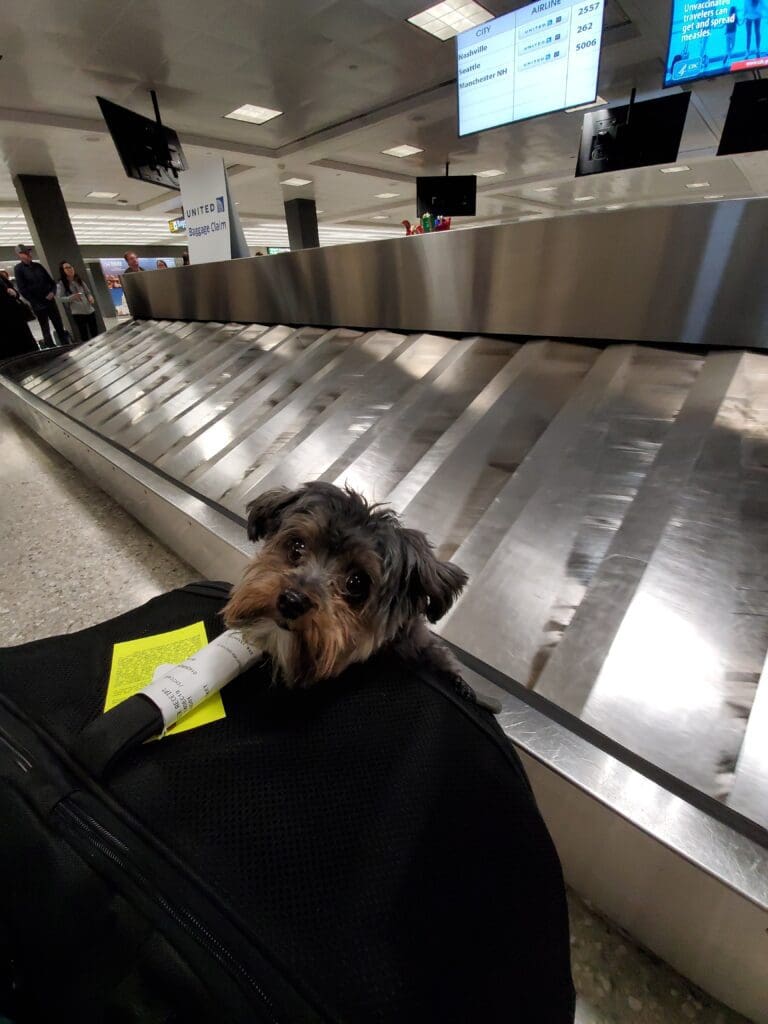
Flying With Brachycephalic Breeds
Certain dog breeds SHOULD NOT fly underneath in the cargo hold, even if other live animals are. Most of these dogs and cats are brachycephalic breeds (French Bulldogs, English Bulldogs, Persian cats, etc.) They struggle to breathe in the lower pressure environments and can die. Fortunately, Frenchies and Persians can usually travel in cabin, but bigger dogs can’t.
Even if your airline is willing to place your brachycephalic breed in the cargo hold, you should not allow it. Either travel with your brachycephalic breed in cabin, drive, or hire a special pet shipper that specializes in brachycephalic breeds.
If you have more questions on brachycephalic breeds in particular, the American Veterinary Medical Association (AVMA) has a great FAQ article.
Flying with Pets – Other Types of Animals
Some people are flying with pets other than dogs or cats – like guinea pigs, hamsters, or birds. Many large airlines, like American Airlines, United Airlines, and Delta Airlines, all have some sort of policy for pets that are not domestic dogs or domestic cats. Some have them fly in the cargo hold and others allow you to take them in cabin.
The best thing you can do to get the most up to date info is to call the airline and ask. Most airlines do allow small household birds to fly in-cabin in a special container as they cannot fly in the cargo hold. Oddly, many Middle Eastern airlines do not allow cats or dogs to fly in-cabin but will allow falcons.
Tickets and Fees When Flying with a Pet
Fees typically run about $125 USD each way ($250 USD roundtrip) for pets in cabin.
If you want to fly with a pet either in the passenger cabin or underneath, you have to call the airline in advance and let them know you are bringing a pet.
There is typically no weight limit on in-cabin pets as long as they are in an appropriate pet carrier, and can spin around and lie in a natural position. Don’t stuff your dog in a pet container to try to avoid checking them if your pet is too big.
Underneath the plane, costs vary based on size and/or weight of the dog. The maximum weight limit depends on the airline but certain breeds, like Great Danes, might need to be shipped separately. Try to book as many direct flights as possible. Loki always falls asleep for the entire flight but wakes up whenever we are in the airport, getting antsy to get out.
Alternatively, on very long flights (east coast to Hawaii), consider breaking it up into multiple days of travel in order to give your dog a break from their crate.
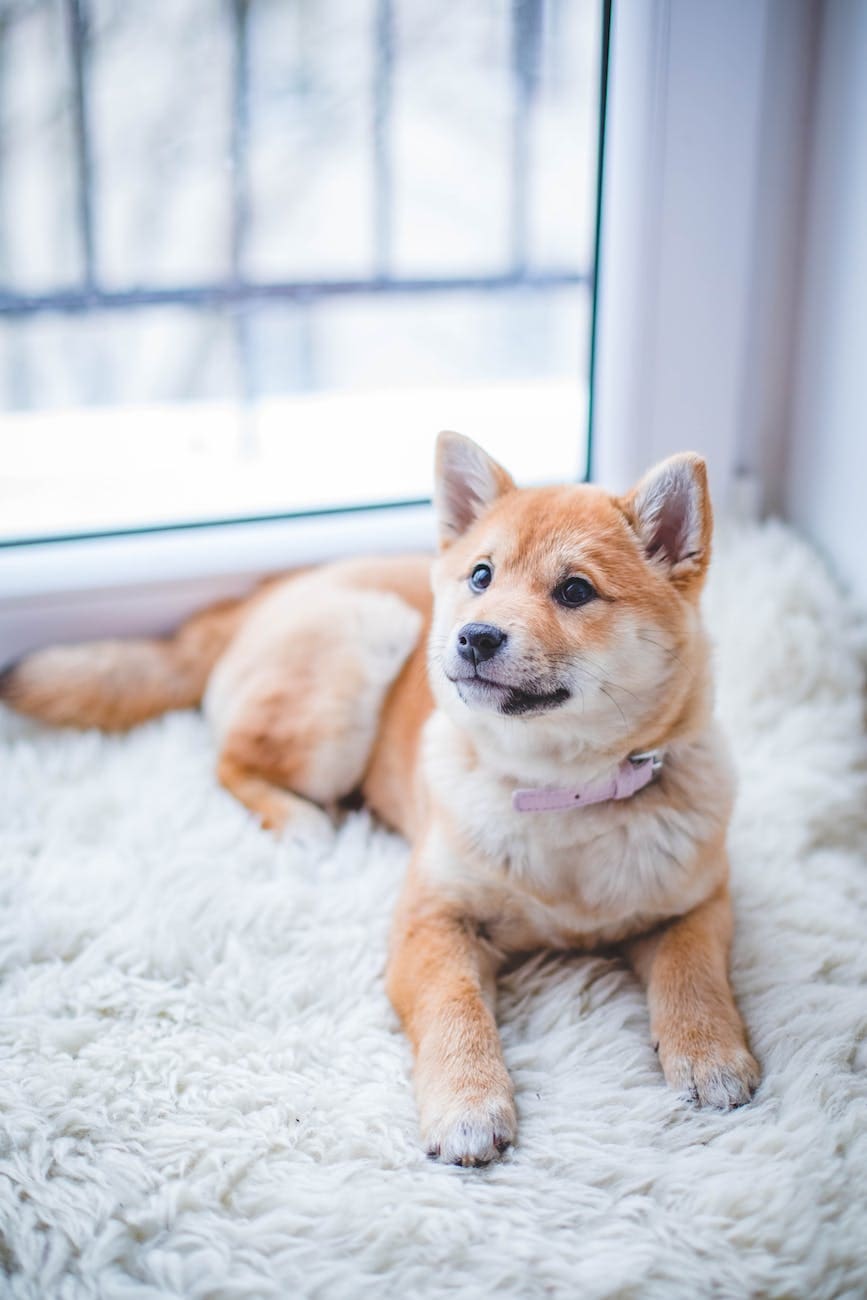
Remember when booking to not book any emergency exit rows. You won’t be allowed to bring a pet, and if your flight is full, you may have to choose a different flight.
Larger dogs have to fly as checked baggage – transiting the cargo area. Most airlines have a limit on how many pets can be in each cabin of the airplane. It’s on a first-come first-served basis. Airlines have a ton of ‘transport of animals’ requests each year. So, call in advance, and if there isn’t enough room for your pet on the flight you want, ask the customer service rep for other options that would allow you to take your dog.
Early morning flights generally have less people and are good if you’re hoping to score an empty passenger seat next to you. Your pet can’t be put on that additional seat though, they still have to travel underneath.
Depending on the type of flight, you may not be able to fly with your dog in business class. This is seat and airline dependent but it’s important to remember if you’re wondering why you didn’t get upgraded.
Service Animals vs Emotional Support Animals
If your dog is a trained service dog (like guide dogs – not emotional support animals), then you likely already know that you are protected under the ADA and should not be charged any fee when traveling in the United States. Emotional service dogs are not protected under this as too many people were abusing the system by bringing untrained animals that bit people or emotional support peacocks onto flights. As such, the Federal Aviation Administration removed legal protections for emotional service animals.

For everyone not traveling with a service animal or psychiatric support animal, like me – we have to pay! I know it’s tempting to claim your emotional support animal is a service animal, print off some cheap certificate from the internet, and avoid forking out the cash required for the pet fee. Please don’t do this! It is super illegal and if discovered you could face all sorts of fines and in some states prison time. Most importantly, it genuinely hurts those who have an actual need to access these areas because people who have bad experiences with fake service animals create barriers to entry for legitimate ones.
So, suck it up and pay the additional fee, no matter the number of animals you are traveling with. You’ll have peace of mind, and a clear conscience.
Vaccinate Before Flying With a Pet
Vaccinations are important things to consider in advance when flying with a pet in cabin. Airlines are always changing up requirements on vaccines so make sure you check your specific airline’s requirements. On domestic U.S. flights for in cabin pets, you do not typically need to show vaccinations.
Rabies:
If you plan on flying with a pet, make sure your dog rabies vaccine is up to date and that you have their rabies vaccination certificate. This is the only one I’ve ever been asked for (United Airlines) and not for years, but you never know when it can happen again. I don’t want to be about to head off on vacation and not be able to go because I did not have something so simple.
Other Vaccines:
If you are like me and routinely traveling between the east and west coast, you might consider squeezing in a quick vet appointment on your adventure. But why? Different regions have different requirements. For example, many vets on the west coast of the United States do not carry any Lyme Disease vaccines – it’s simply not an issue out west.
Back on the east coast however, ticks are abundant in certain seasons and Lyme Disease is far more common. If I’m flying with a pet to a new part of the country, I always check with a local vet to see any gaps in his vaccines that might put him at risk while we explore a new area. I also make sure his flea and tick is up to date.
Copies of Records
When flying with a pet, I like to have photos of my pet’s medical records and have their vet’s number handy just in case. If you ever see any vaccine requirement, it’s almost always for rabies. The USDA allows states to issue the entry requirements for pets. Most states allow privately owned dogs and cats to enter from other domestic locations in the continental U.S.. Airlines have varying regulations but most don’t require a health certificate.
As such, you do not need a health certificate from your vet to travel domestically but it is standard practice when traveling internationally. Further, there are often special destination requirements (i.e., Hawaii, Puerto Rico, or the U.S. Virgin Islands) that may have extra requirements. Basically, if it’s an island, I’d double check.
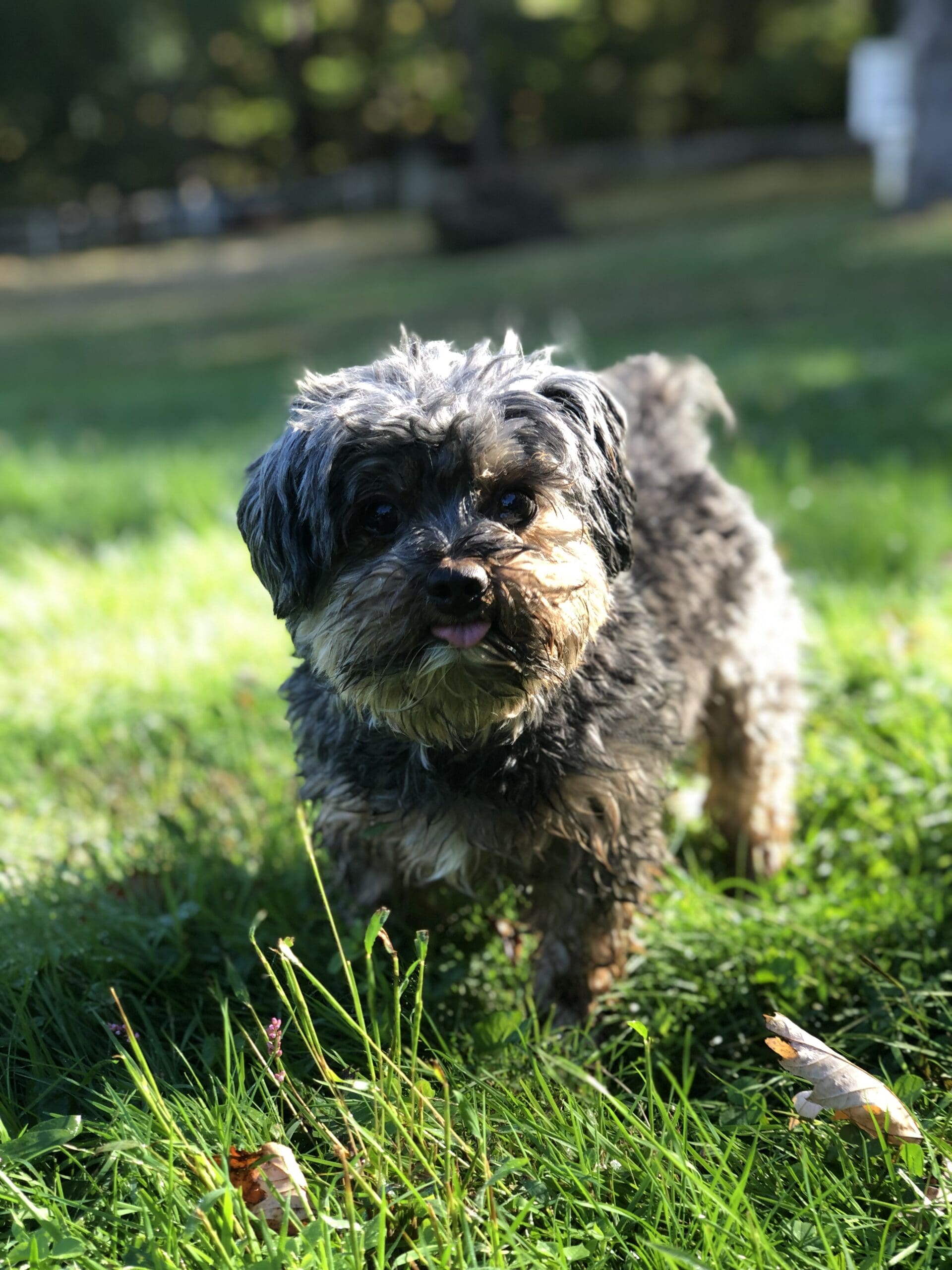
Packing List for Pet Parents:
It’s easy to come up with a packing list – just imagine the worst case scenario if your bags are lost or your flight is delayed and what you might need for your animal. There are several thing you should have with you in your carry on when flying with a pet:
1. Travel Carrier:
Okay yes, it sounds obvious but there was a time when I drove to the airport with my dog’s head out the window enjoying life only to realize his carrier was at home…
2. Food
Bring about 2-3 days’ worth of pet food when flying with a pet, even if the flight is shorter. You might have more in your checked luggage and that’s great, but airlines lose bags. Also, one time over the Christmas holiday, my direct flight had to make an emergency landing in Denver, Colorado. They wouldn’t put us up in a hotel because our flight was the following morning (also delayed).
I had dog food in my checked luggage but forgotten to put it in my carry on. After scrounging the airport for something he could eat, I gave him part of a hard-boiled egg for breakfast. He was happy, but I’ve never forgotten dog food since. Try not to change your dog’s diet when you travel as this can upset their digestion.
3. Harnesses and Leashes:
A leash and harness. This is great for any animal when when flying with a pet, whether it’s a dog or a cat. You never know when you might need to take them out of their carrier so they can stretch their legs in the event of a delay.
4. Bowls:
You can always buy water bottles in an airport or fill up at the water fountains behind security. Bowls can be hard to find behind security so I bring my own. REI has some good collapsible ones.
5. Poop Bags:
Dogs, cats, rabbits. Animals poop. When you’re flying with a pet and you let them out to stretch their legs in the airport, they might poop (use the pet relief areas). It’s good to have something on you to pick the poop up at the airport– and at your destination. #ResponsiblePetOwner. I like to get the compostable ones because Loki can really go through plastic bags.
6. Paper Towels:
Accidents happen and it sucks when you’re 100 yards away from a bathroom to clean up a mess. Just bring some paper towels along just in case.
7. Toys:
When you are flying with a pet, you don’t need to bring the entire toy collection, but a favorite toy or two is a great way to make your pet feel at home. Plus, on any long layovers, it makes any stretching time extra productive. Your pet probably doesn’t have a ton of room in their carrier but if it’s a small, soft toy, it could probably go in with them as a comfort item. If it’s a hard toy however, no matter how much they love it, do not keep it in the carrier. In the event of turbulence, it could injure them.
8. Treats:
Bring treats when flying with a pet. For obvious reasons. They deserve it.
9. Medicines:
Bring any medicine your pet may need when you’re flying with a pet because you won’t be able to get it behind security. Bring extra in case the airline loses your checked luggage or you have an unexpected layover.
10. PeePads:
Pee pads are particularly good when flying with a pet, especially there is no pet relief area behind security on a layover or on a long-haul flight somewhere.
The Day of the Flight
Okay, you bought an airline approved carrier whether it’s the Sleepy Pod Air or something else. Your pet loves their carrier. You have their vaccines just in case and you’re heading to the airport to fly somewhere domestic in North America. What should you do? What should you expect?
Exercise before Flying with a Pet
Flying with a pet is better when your pet is tired. On the day of travel, take your dog on a nice long walk (or have a robust play session with your cat). Do what you can to make them tired, and ensure they use the bathroom before heading to the airport.
At the Airport, before entering, see if they have to go again. Many airports, especially those that act as hubs for the major commercial airlines, have pet relief areas both outside the airport and inside behind security. For example, Las Vegas McCarran International Airport has seven pet relief areas for anyone flying with a pet.
For safety reasons, you should not give your pet a sedative. The variations and pressure and oxygen levels can be very dangerous for them when mixed with medications. Instead, the safest way to travel with your pet is to wear them out the good old-fashioned way. It’s a much better option.
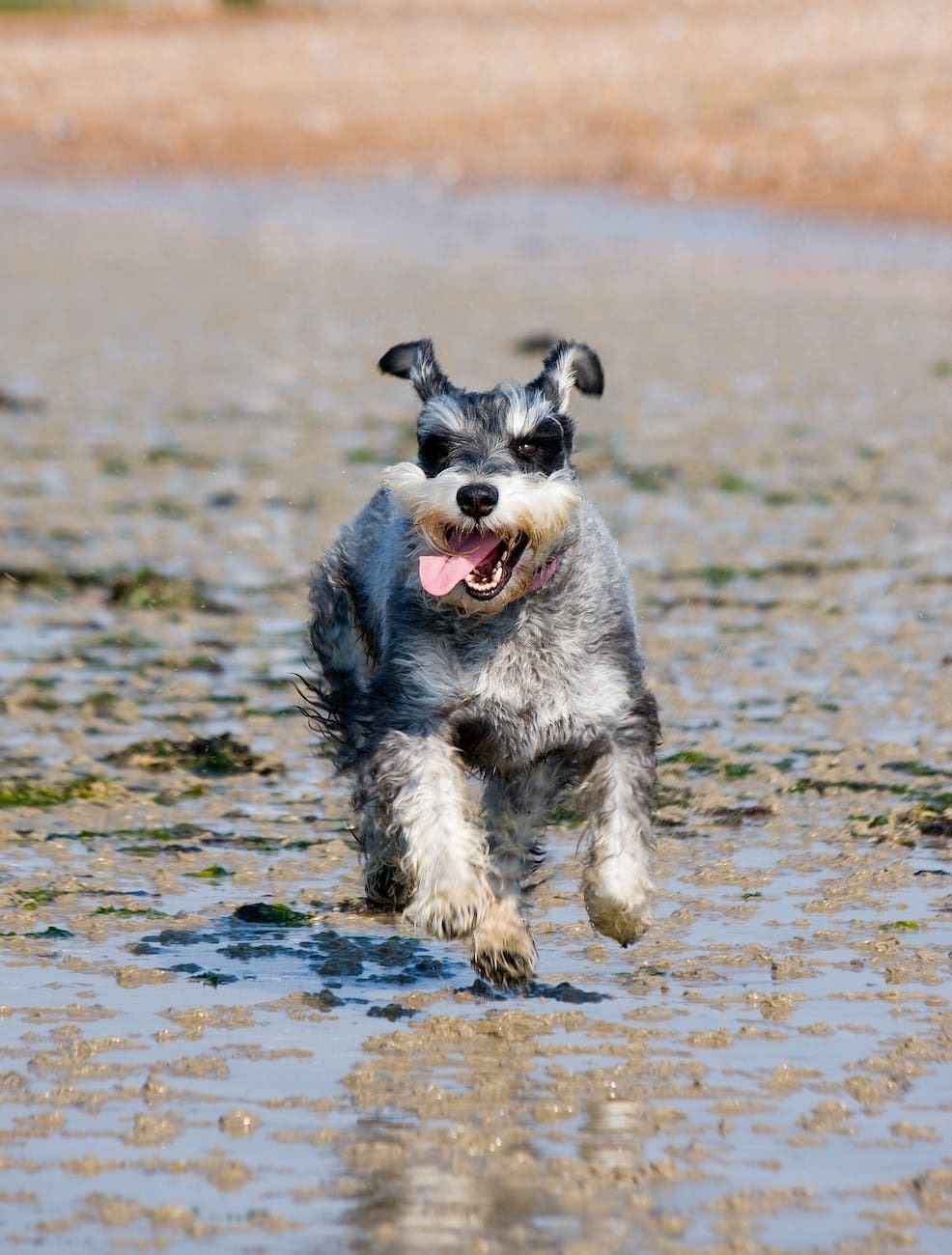
Check-In When Flying With a Pet
When flying with a pet, you won’t be able to check-in online. So, on your date of travel get to the airport a little earlier than normal (like 1.5-2 hours before your flight) and check in at the ticket counter. Alert the check-in counter to the fact that you’ll be traveling with a pet in cabin. Most of the time they’ll have you sign something and give you a little tag to place on the carrier. You should have called your airline at this point to pay by credit card.
Most of the big airlines seem okay with you bringing a pet and your carry-on baggage (a bag and a personal item) but I think technically they can say that the pet is your personal item. I’ve never had this happen though.
Going through TSA for Pet Owners
Only one thing to remember when flying with a pet and you transit TSA:
DO NOT SEND YOUR PET THROUGH THE X-RAY MACHINE.
I’ll say it again DO NOT SEND YOUR PET THROUGH THE X-RAY MACHINE!
Going through TSA is seamless when flying with a pet. You walk up to the TSA officer and hand them your ID. He scans it and sends you to an x-ray line to go through the security checkpoint. You can ask them any pet questions but it’s not necessary.
When it’s your turn to unload your baggage. Place everything on the rack, including the pet carrier. Then, if you don’t have TSA Precheck or Global Entry (you should really get those) you’ll take off your shoes and take out your laptop. Finally, take your pet out of the carrier and remove anything metallic (collars/harnesses). Send the carrier through the x-ray along with all your other bags and walk through the human x-ray machine holding your pet and following any instructions the TSA agent gives.
Expect lots of “aww how cute” from everyone who didn’t realize you had a pet in the carrier.
Behind Security
Congratulations! You’re behind security and one step closer to finally flying with a pet! After security you can head straight to your gate. Some people use this as one last chance for their pup to stretch their legs. Usually, the airport is too crowded and people are rushing around so much that your pet would get stressed dodging hundreds of pairs of feet and carry-on suitcases. I typically just open the top of the bag and allow him to peer out at the world as we roll around.
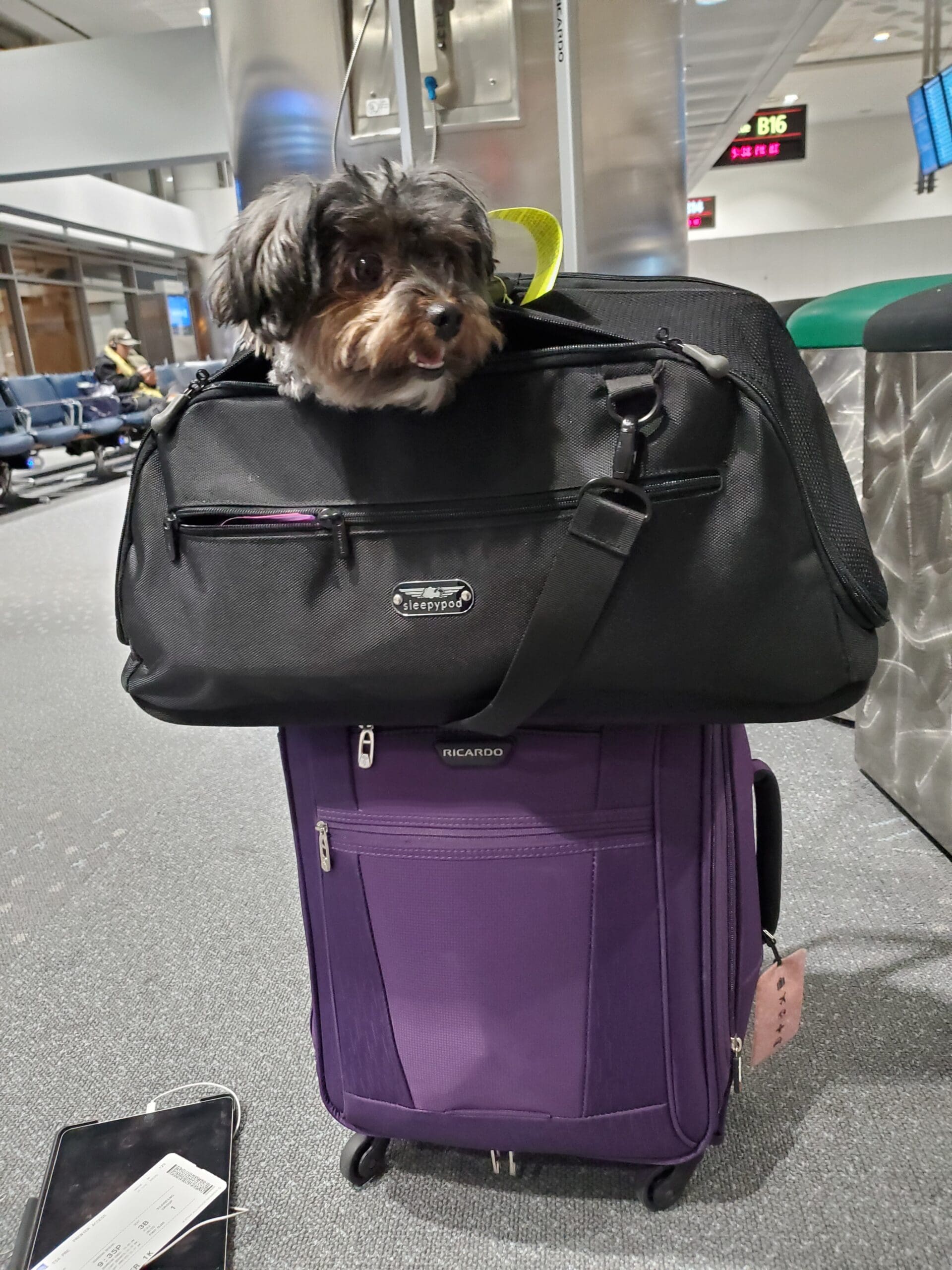
Boarding and Flying:
Boarding is also simple. You don’t need to do anything different than normal. Just board the plane and go to your seat. DO NOT put your pet in the overhead bin. The only safe place for them is beneath your seat. Make sure there is enough space around their carrier that they have good air flow. Remember, you are your pet’s only voice – their only advocate. If something feels wrong to you, say something to the flight attendant or, if needed, the pilot.
Unlike the airport where people tend to play fast and loose with the rules, the airplanes tend to be very strict that your pet remain in their carrier at all times. This is for the pet’s safety as well as for the respect of your fellow passengers.
There was one time and one time only a flight attendant asked me to break this rule:
I was flying with a pet (my dog Loki) across the United States during the height of the COVID-19 pandemic. The world was shutting down and I was trying to get home. My flight had 9 people on board (including staff). After clearing it with the other passengers, the flight attendants came over and asked, “Can we ask you to take your dog out so we can say hi. We all need a little comfort right now”. So, I did, and Loki was THRILLED to be seated next to me and getting all the attention as people walked past.
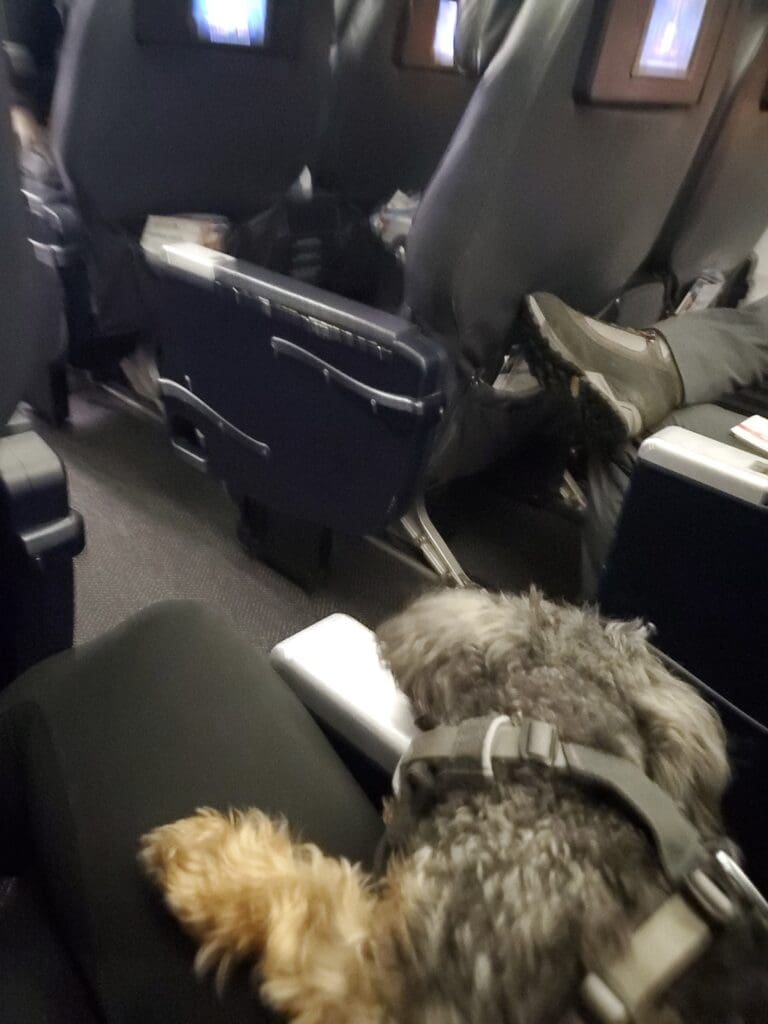
Layovers when Flying with a Pet
Layovers can be stressful when flying with a pet. If you’ve got enough time, try to find a pet relief area. Many airports have them behind security for traveling pets. You can usually find where they are located with a quick google search on your phone. If your airport has no pet relief area behind security, consider bringing some pee pads, just in case.
Departing the Plane:
Phew! You made it!! There is almost always a delay between getting off the plane and your checked luggage arriving. I like to take advantage of this by stepping outside with my dog, if there is a safe space nearby, to let him use the bathroom. Then you just grab your bags and off you go!
Emergencies while Flying with a Pet:
In the event of an emergency, you should contact a Vet immediately. Make sure to have the number handy (as well as a phone charger for your phone). You can learn about some common emergencies and the proper actions to take at the ASPCA website.
If the thought of flying with a pet is still too much, why not get a Rooftop Tent and drive to your destination with your pet?! Everyone loves a road trip!

